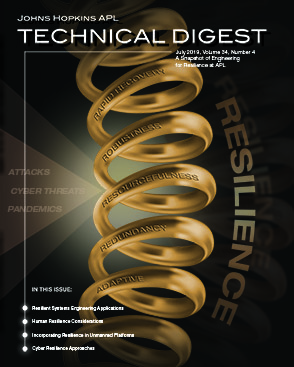
A Snapshot of Engineering for Resilience at APL
Volume 34, Number 4 (2019)
Today’s systems are increasingly complex and interconnected and face ever more sophisticated threats to their ability to operate successfully. It is no longer enough for systems to be robust and reliable; they must also be resilient. Although reliability and risk concepts have been codified in systems engineering for decades, resilience is a relatively new concept for the systems engineering community, so the definition of the term/concept is evolving. However, most definitions center on the ability to provide required capability in the face of adversity or disruption. Of course, this is a broad definition, and the potential applications of resilience concepts are equally broad. The articles in this issue provide a glimpse into work being done at APL to develop and measure resilience approaches to ensure that our systems are able to respond to adverse events in real time, enabling them to succeed in their missions, whether on land, at sea, or in space.